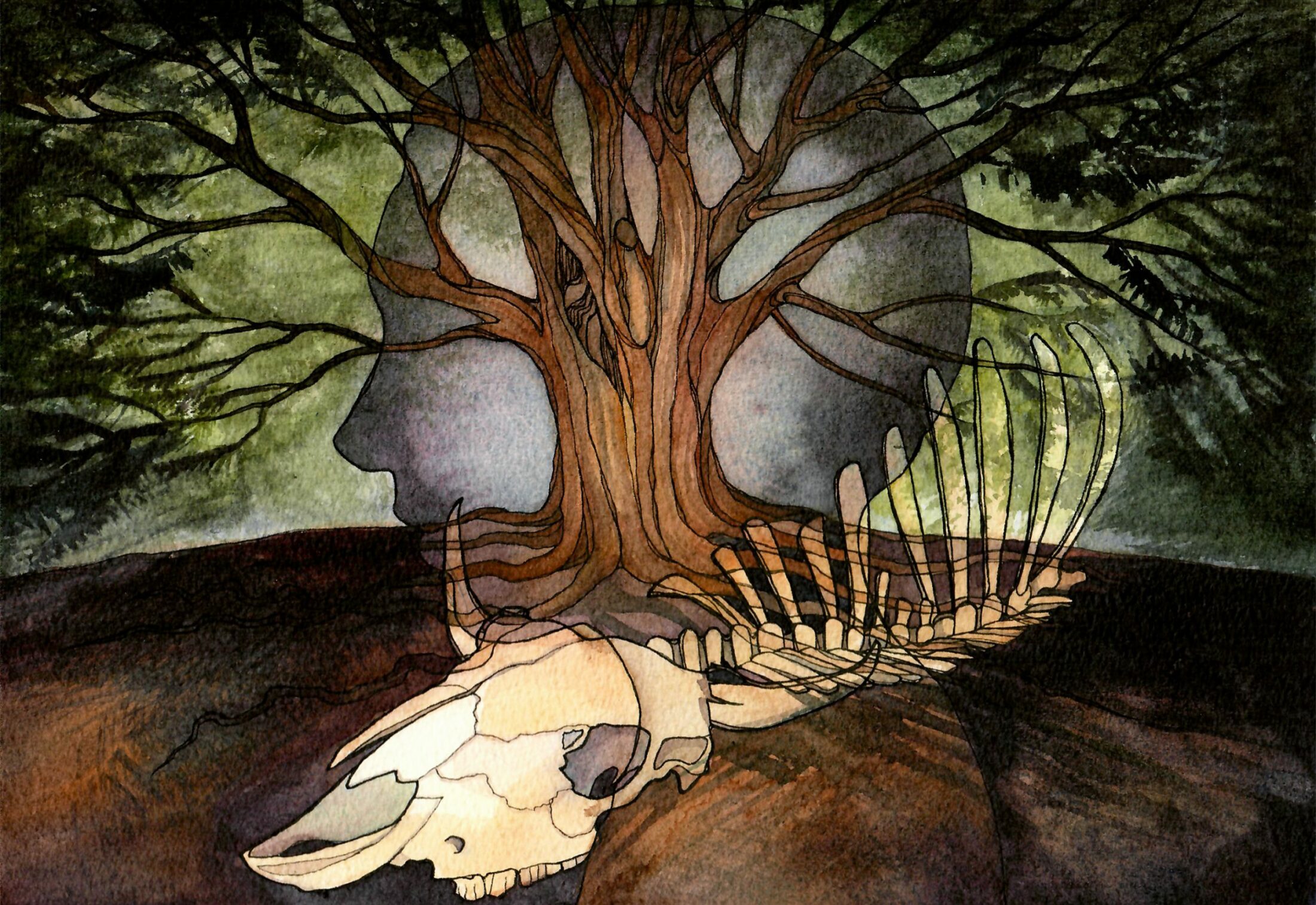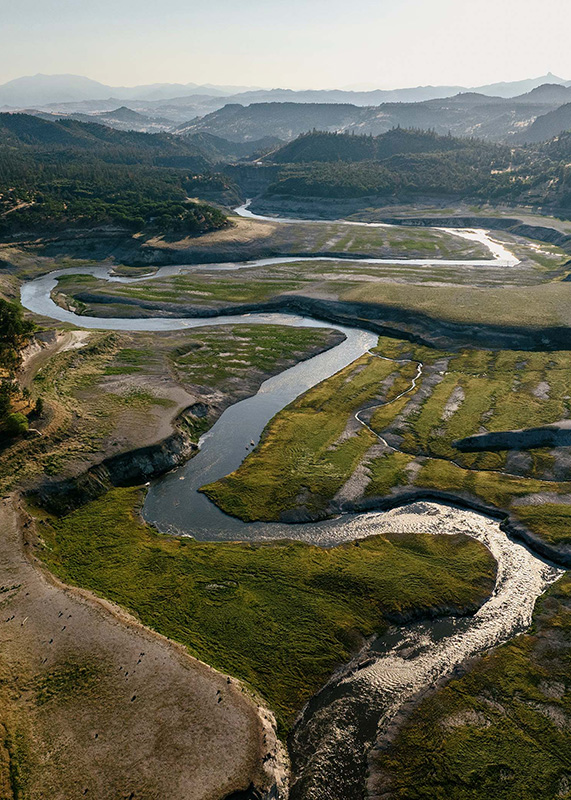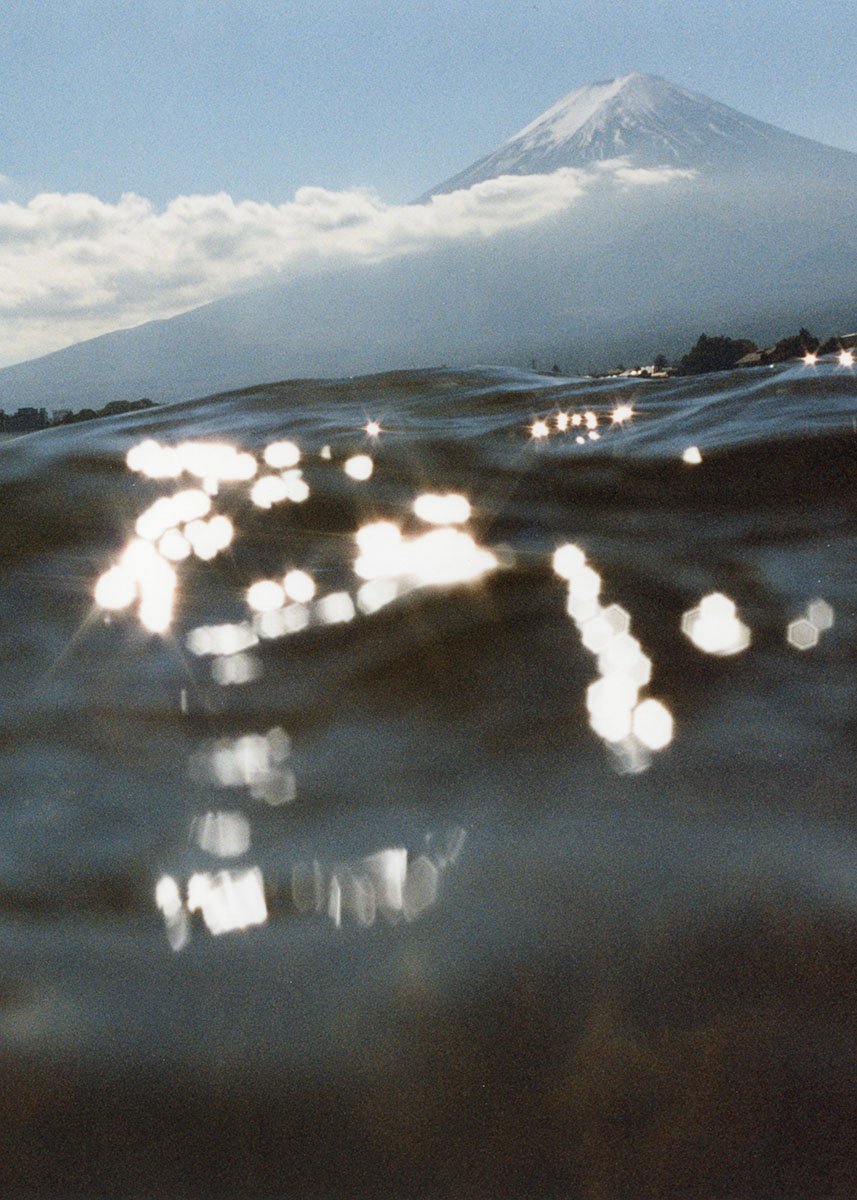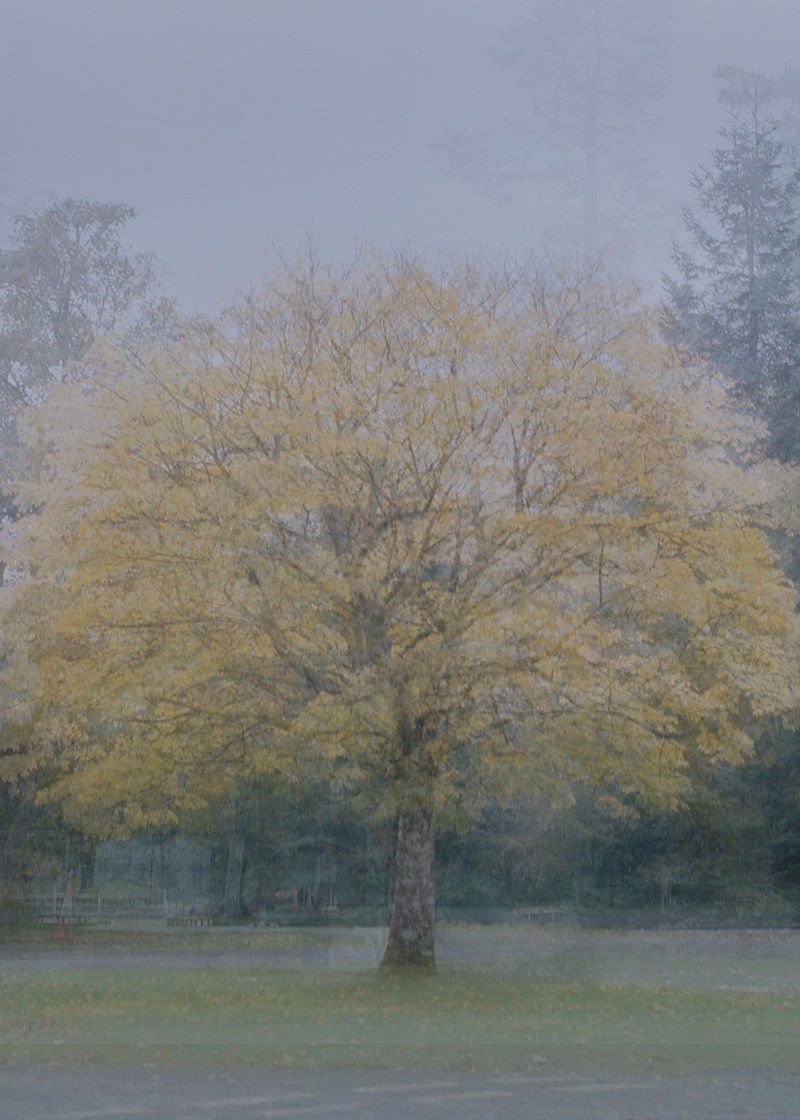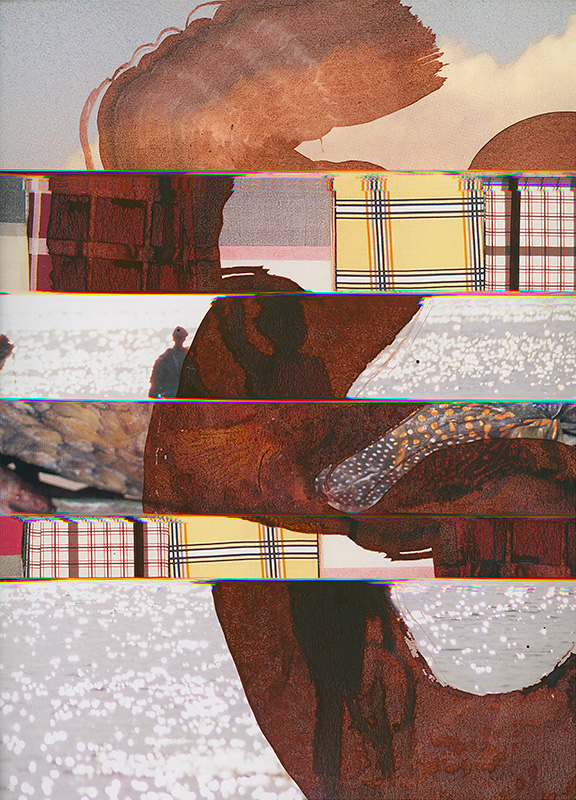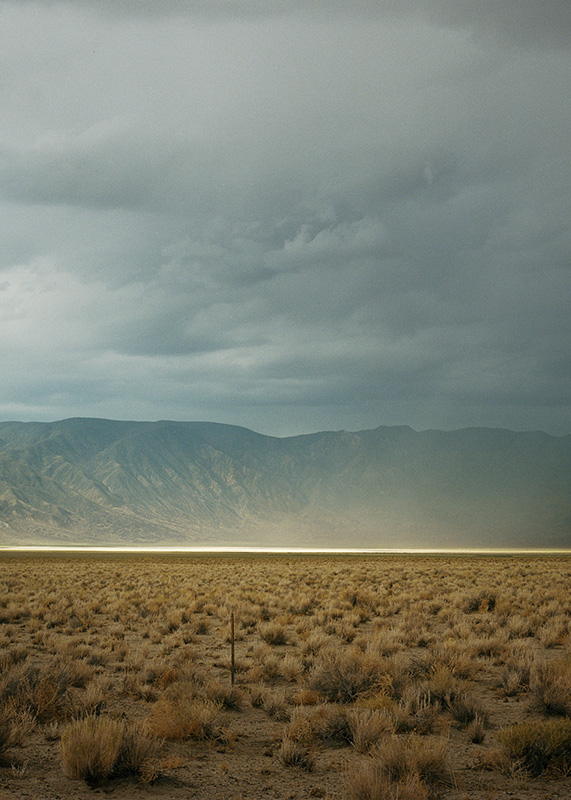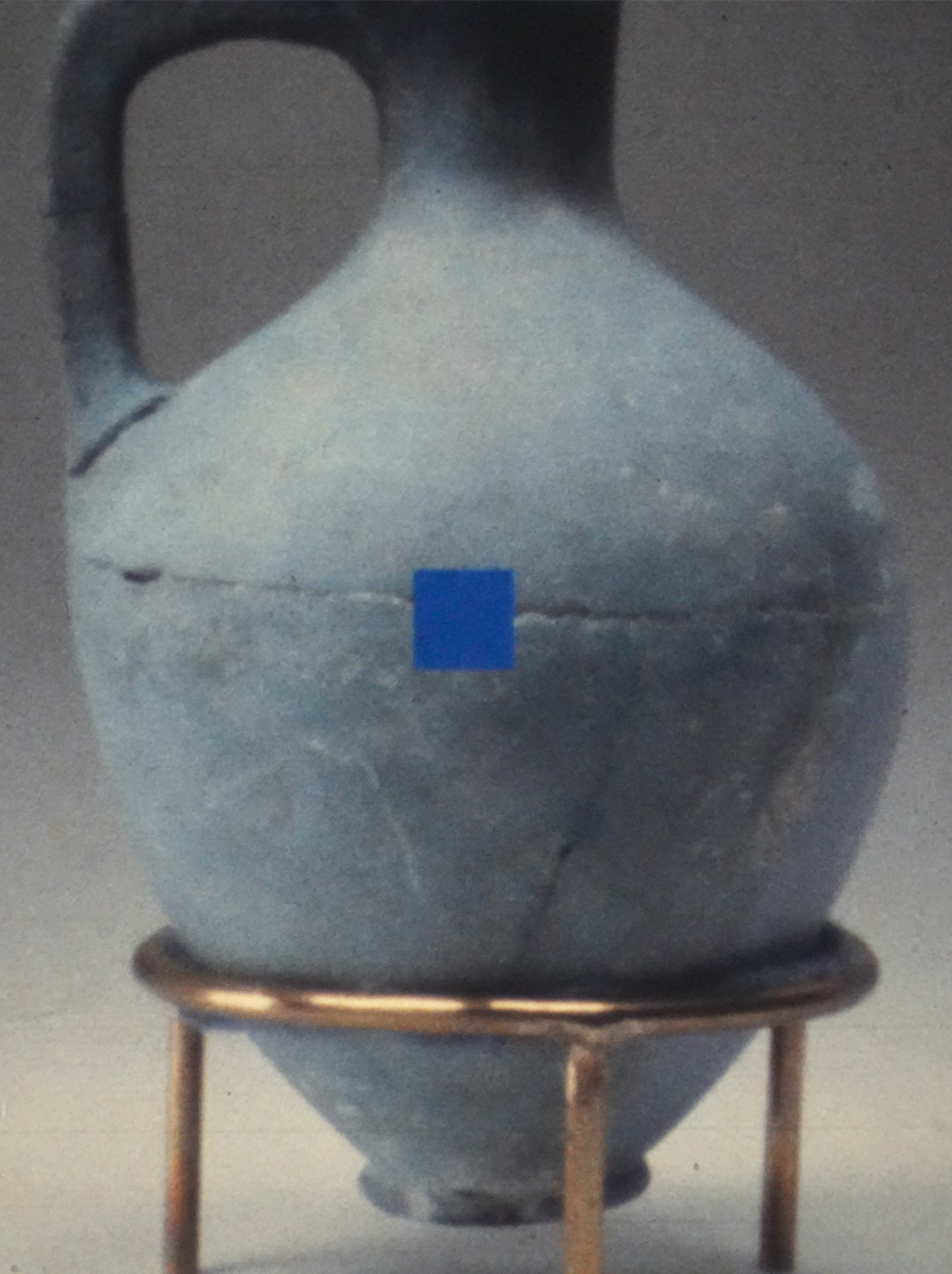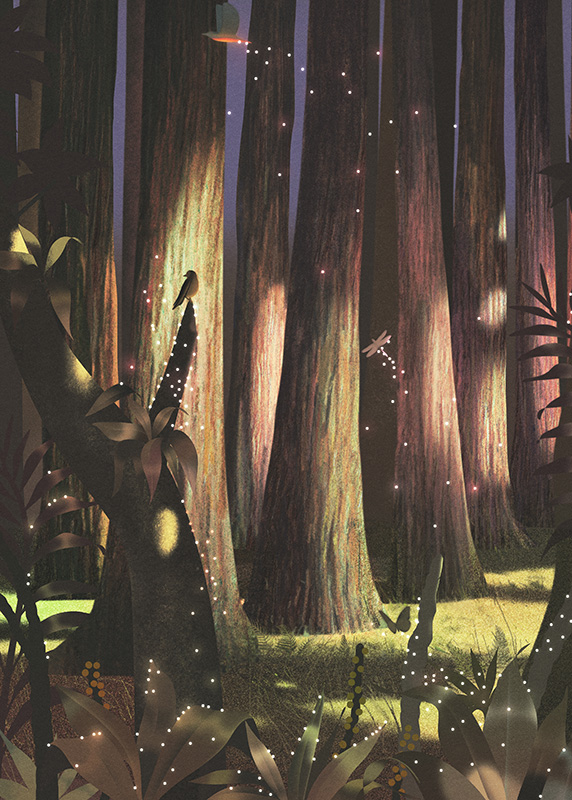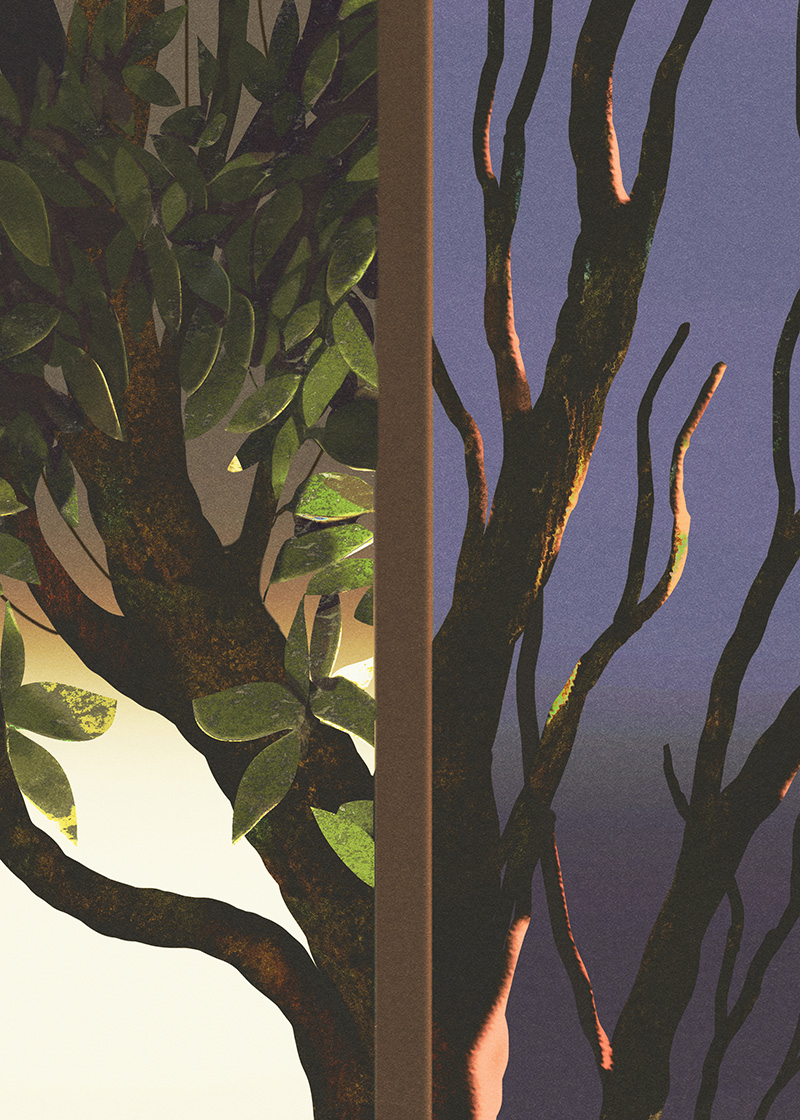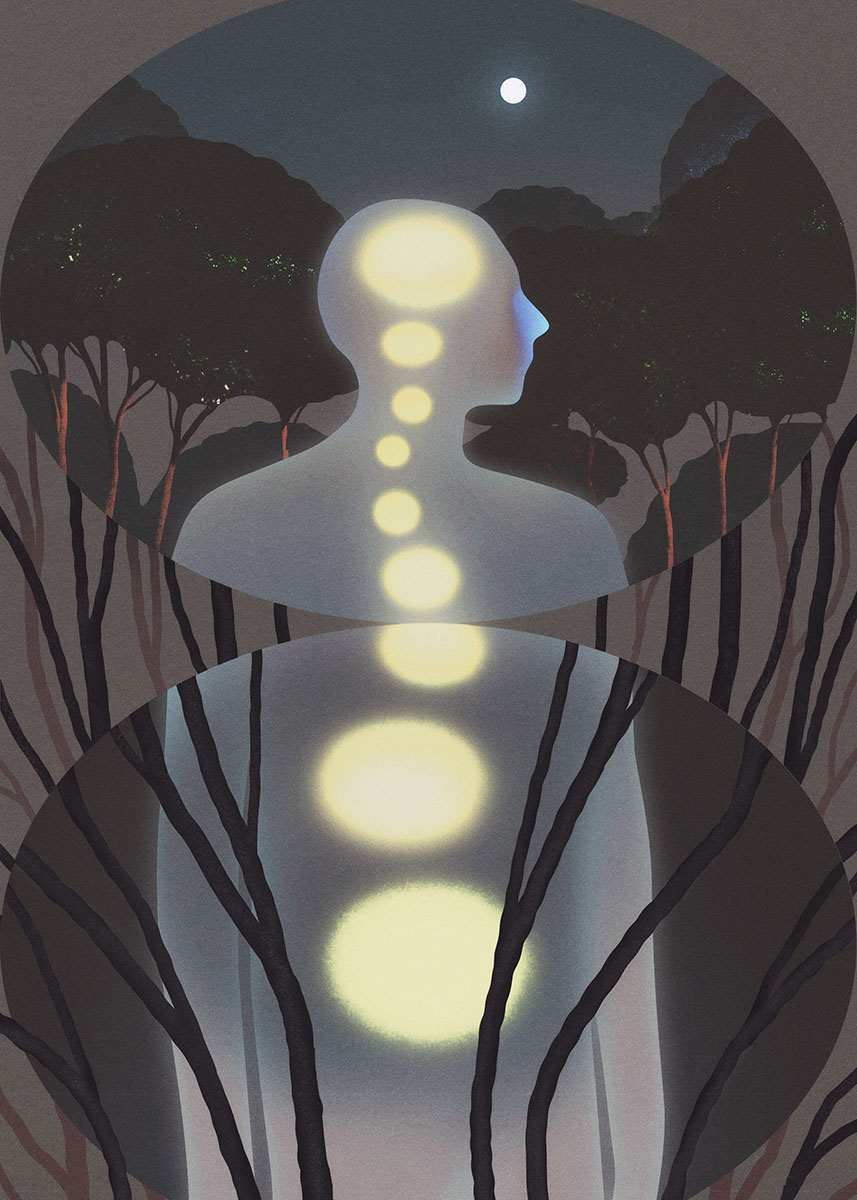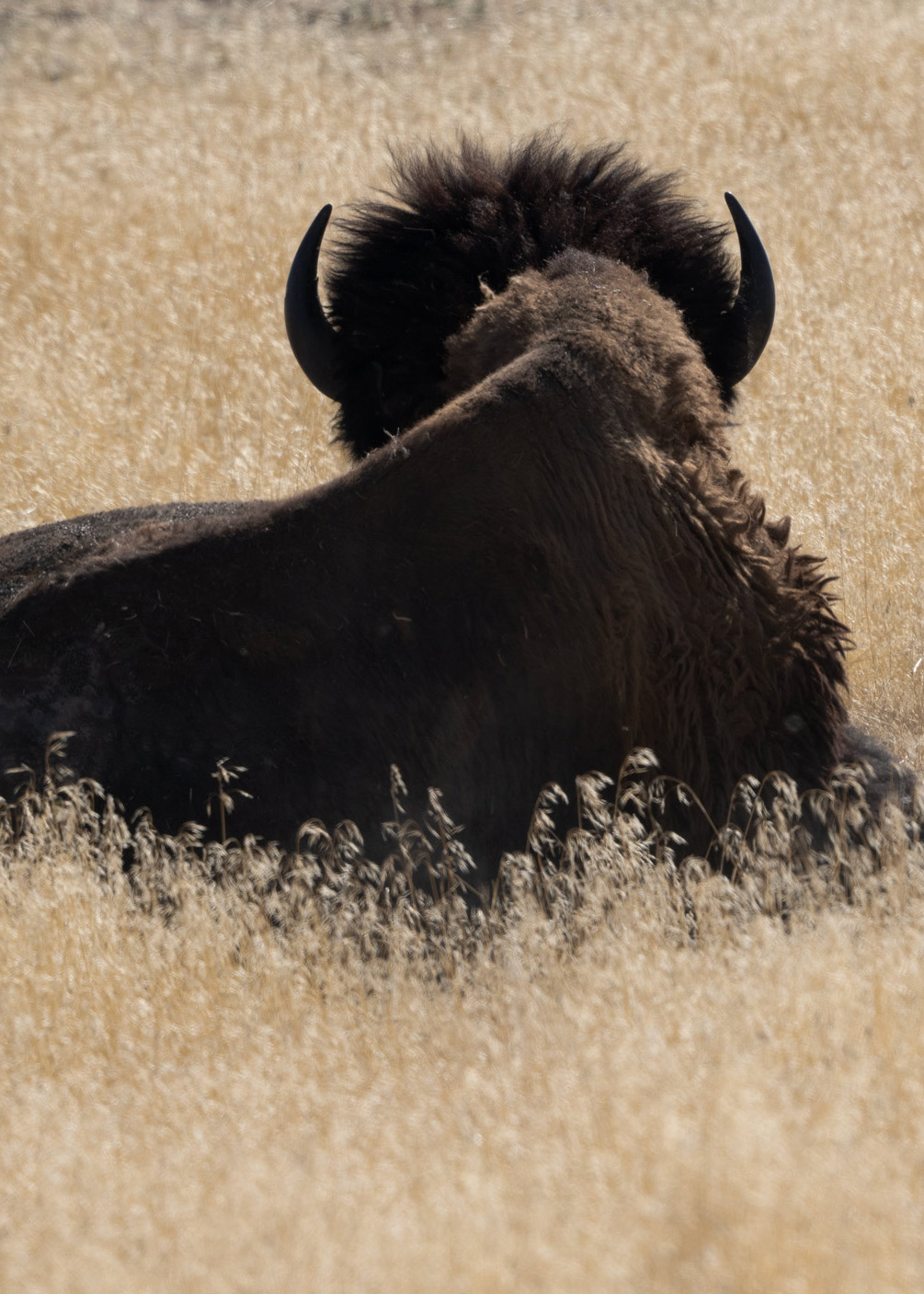
Daisy Hildyard is an English novelist and essayist with a PhD in the history of science. She is the author of two novels, Hunters in the Snow, winner of the Somerset Maugham Award and a ‘5 under 35’ honorarium from the USA National Book Awards, and Emergency, winner of the RSL Encore Award; as well as the essay collection, The Second Body. Her work has appeared in The New Yorker and Granta, and she has written book reviews for The New York Review of Books and The Times Literary Supplement. Daisy lives with her family in North Yorkshire, where she was born.
Eden Gallanter is an artist working primarily in ink and watercolor. Her work is informed by her background in English literature, restoration ecology, and neuroscience. Her most recent exhibitions include: Virtual/Window #1 at Avenue 12 Gallery and Women Rising at The Drawing Room Annex, in San Francisco. She lives in her home town of San Francisco with her wife and daughter.
Daisy Hildyard examines how the COVID-19 pandemic has drawn our attention toward the space between things. She notes that these “negative spaces” reveal relationships that normally lie beyond our perception. The intertwinement of our lives—human, plant, animal—has become more apparent: our lives trace through other beings, and their lives trace through our own.
Now is a time to think negatively. At some point in the last year, two viruses were co-existing inside one animal’s body. Reader, they got together. A novel virus was formed, scientists currently propose, inside a pangolin’s body, from a reservoir in a Rhinolophus bat. This virus, a chimera, was able to cross species boundaries. In late 2019 it began to communicate itself through human bodies.
As the spread of the virus through the human population gained momentum, people from many different parts of the planet gained a new sensitivity to previously unnoticed worlds. These were the worlds of negative space—the spaces between subjects—worlds which had been invisible, transparent, or simply overlooked. A sneeze disperses around the room in a pearly cloud; populations of millions are hosted on a fingertip; body warmth from another person’s hand leaks only slowly out of a coin or a door handle. Phenomena that lie beyond the faculties of human perception have become the subjects of widespread, mainstream public health campaigns attempting to make human minds alert to those minuscule living beings who occupy the negative zone between skin and air. Germs and viruses, like radioactivity, are imaged as a pool of neon green—the most natural color in its most lurid tone. It feels uneasy, expressive of a longing to escape the fact that viruses and respirators, like nuclear reactors, are a part of our natural world.
It’s time to think negatively, too, because there is no avoiding death. If you are one of the fortunate people not at risk of death from COVID-19, you will have a heightened awareness of the inside-out power of your own negative acts—the outings you don’t go on, the meetings you do not attend—and that these not-done things will, in turn, imprint the shape of your life on other lives; your choices and necessities are revealed, in relief, in their effects on the other people who you do not touch, meet, pass, travel beside, work with, sell to, purchase from, or care for.
The consequences of the virus—which breach boundaries at every scale, from the intracellular to the global—leave even the most positive thinkers struggling for air. A negative thinker, though, might find a new interspecies space. I had, for some time, been thinking about deaths when the virus started making its presence felt, and it drew my attention to the practical uses of looking negatively.
I am, I felt, badly in need of new ways of relating. But thinking about relationships is difficult. I don’t want to think only from my own perspective, because that would become narcissistic, and swiftly boring. On the other hand, I do not want to project or imagine the experiences of others when I have not earned the knowledge of those experiences.
The new negative awareness makes me wonder whether it might be possible to see new stories in our relationships—stories in which a subject is comprised of its interactions with others; and those others have force. This was made apparent to me as I read about the rising prevalence of zoonotic diseases—diseases which jump between species—as a result of widespread, large-scale human behaviors like industrial farming and habitat destruction. The negative zone which I had recently become hyperaware of—the spaces between things, the points of connection—could offer new ground for noticing or listening to other ways of being. I wondered whether it would be possible to make any sense of these interactions as a felt presence, in absence. To feel interconnection in conditions of unprecedented enforced solitude. It seems logical—in the negative space created by a disease, which has acquired the ability to cross species boundaries—to examine the conditions of interspecies lifeways by looking at interspecies deaths.
There is a large ash tree in my local park which is still alive. It’s tall and thick-trunked; it’s planted in the grass, with roots so substantial they make waves in the tarmac on the nearby path. Some hippies have carved into the trunk a sun with a face. The tree is so large and so apparently vital that I find it hard to believe that it will die, but one day it certainly will, and that day is likely to come soon. The fungal disease known as ash dieback is predicted to kill 99 percent of ash trees in Europe; this specific tree is likely to become a constituent subject of this voracious and spreading death.
When I first read about ash dieback in the newspaper, I thought about this tree. I wondered whether it had already contracted the disease, and I was concerned, as I read about the slow and at first invisible spread of symptoms, about the experience of sickening and dying. The next time I walked past my ash tree, though, looking at the smiling sun on its trunk and the black buds shaped like hooves that were pushing out of its smallest twigs, I felt that it probably wasn’t hugely concerned with feelings. I could never, of course, learn what it would feel like to be an ash tree. I borrowed a couple of books about ash trees, but something was missing. I realized that I was relatively ignorant about the actuality of mortal illness, and that, rather than fantasizing about this experience within an ash tree, I might also listen to an account of this particular experience in a body that was not a tree.
I contacted a local hospice in which a close friend’s mother had recently died. Some time later, I received an email from a Dr. Kaur, who asked politely about the nature of my inquiry. I explained to Dr. Kaur that I was interested to hear a perspective on extinction from somebody who was no longer personally invested in survival. Dr. Kaur put me in touch with a woman called Anne, who had been diagnosed with breast cancer in her thirties and was now, in her fifties, living with brain cancer.
Anne and I sat in a small side-room at the hospice, which was much like a doctor’s consulting room, though the chairs were more comfortable. I was nervous, but from the outset Anne was happy to talk to me because, as she told me, she felt at peace with the concept of human extinction. Though she wasn’t particularly engaged with narratives of climate emergency and extinction, she noted that mass extinctions had happened before, and she had come to terms with the fact of death. When I asked her about her individual experience, she said that the thought of her death made her feel sad because of her children—her children were adults, but you always need your mum, don’t you, she said. So she saw her life as something which was formed and had meaning in relation to other lives.
On the way out of the hospice, I had a conversation with Dr. Kaur. He was a religious man and spoke beautifully about the composure and fulfillment that can come about at the end of life—there is a type of sunflower that will bloom only in the desert, he told me—but he also described the moment of death as shocking and traumatic. While he was talking about this, he mentioned that the Greek term for “good death” is euthanasia. I asked him about his feelings on euthanasia, and he was noncommittal but made an interesting comparison: humans experience pain in dying that we wouldn’t allow an animal to suffer.
I say that this comparison is interesting—what’s interesting to me about it, in a way, is that it’s so predictable. It would seem to me almost inevitable to compare human euthanasia with putting an animal down, because they share this narrative that a good death can be a solution to suffering. The comparison is not anthropomorphism, exactly—it isn’t about projecting human characteristics onto animal lives. It involves a more complicated process of identification and imagination. A bewildering and unknowable aspect of human life is given ground in this experience which is a reality for nonhuman animals. And when a vet puts down an animal, the grounds for doing so call on a reasonable projection of the suffering that the human believes the animal to be experiencing. Dr. Kaur was navigating across species boundaries to help us both make sense of what it might be to live a good death—he used differences between species to draw attention to similarities. The boundaries between species poke up, becoming apparent when a disease acquires a new ability to communicate itself across them, and so, like language, they are most noticeable when broken. But passages through these boundaries are always at hand, in an ordinary way, at the critical moments, in the hospice or the veterinary mortuary.
The fact that Anne felt sad about her own absence when she thought about her children is interesting to me because it is unsurprising. I would guess that many human beings, if facing the prospect of death as Anne had, would find themselves thinking of not only the absence itself but also the way that absence would make itself felt in other people’s lives.
These experiences of death then—from the perspective of the doctor or the patient—have some negative sense of what it is to live. Though they are thinking and talking in different contexts, in different ways, they see the critical experiences of life via its constitutive others. They suggest to me that the concept of a life as something which is characterized by its relationships—something emergent—is already available to human thought. This is the case even if our interconnectivity makes itself felt only during a disaster like a radiation leak or pandemic, during which the agency of nonhuman beings becomes suddenly and terribly obvious, not only in the fact of its existence but also in the fact that it is often beyond the capacity of the human senses to detect it.
And yet in ordinary life, outside the disaster zone, these interrelationships are often denied. I deny them conceptually, when I think of myself as an individual. I deny them practically, when I use pesticides that sicken those they are designed to convenience. I wonder whether this human habit of denying interrelationships is in fact a consequence of interconnection—a need to separate oneself from affinities or responsibilities which would be painful. Anne had mentioned that she’d struggled to be heard by her doctors, family, and colleagues. She was a middle-aged woman who had worked in a supermarket before she became ill, and she described herself as unassertive. She struggled to get a diagnosis or proper treatment.
I was struck by the connection between these factors, as it came up several times, and I asked her how others might have done things differently. Anne responded with practical, physical advice, and what she described sounded to me like a process of attunement. She said: Adapt yourself to the patient physically. Make contact. Be polite even if they have debilitating physical symptoms. She compared this attunement to speaking with children: the way you might bend down to the child’s level or be more tactile if they can’t yet talk. And even if you don’t have much to say to a person, you can still listen or make some gentle physical contact. That seemed to strike her as especially important as it came out, and she said it again more emphatically. Listening, she said, is a massive thing.
The consequences of the virus—which breach boundaries at every scale … leave even the most positive thinkers struggling for air.
A few years ago, one autumn, I was visiting my parents on their farm, and there were two young female cows in the small field in front of the house. The heifers were only a few months old, being kept in this small field because the bull was with the other cows. My father did not want these two to carry a calf that year, because he thought they were too fragile.
The heifers trotted over when we appeared in the garden on the day I arrived, and my daughter, who was a baby then, tried to stroke them. They were cute, their hides still clean white, long eyelashes, nosy. The next morning one of the young cows was lying dead in the field, and her cousin was standing beside her, head down. The corpse was bloated. She had seemed healthy, so it was a mystery and worrying.
Just above the field she was in, there was a small yew tree that had recently been clipped. Yew trees are poisonous—in England they are traditionally planted in graveyards to deter cattle or sheep from wandering on the graves. In gardens there is a centuries-long history of yew topiary, in which the shrubs are transformed with shears into smooth green walls, pyramids, marbles, or birds. Today, pharmaceutical companies pay per kilogram for clippings, because there is a compound in the young green shoots that can be used in certain chemotherapy treatments. So the yew tree is a critical cure for some people, but it is also poisonous to cows. That day at the farm, we thought that the poisonous clippings might have fallen below the wall when the garden hedge was trimmed, and this was what might have killed her.
I looked up yew poisoning on my phone to try to establish whether her corpse suggested yew poisoning. I found myself plunged, however, not into veterinary science, but into an online forum in which suicidal people debated the pros and cons of using yew to poison oneself. Suicide by yew was, among the anonymized voices of the forum, found to be an interesting if niche method, but there was some concern that the poison might make the corpse swell up and look ugly and purple. I closed my browser and put the phone down. I had a certain new insight into a human world I hadn’t known before, but I wasn’t much wiser about cows.
A postmortem would be prohibitively expensive. The cow, of course, could not go into the food chain. My father told me that the cow would receive a rudimentary examination at what is called the knacker’s yard, which has a license to dispose of dead farm animals. The knacker’s yard produces household goods like leather or glue out of the dead bodies. The people who work in the knacker’s yard, who are not vets, have a certain practical and experiential knowledge. They will open her up and have a look, my father told me. When this young cow’s stomach was opened a few days later, he sent me a text to say that it was not full of yew, that she might have died of a common disease known as bloat.
My encounters with Anne and Dr. Kaur at the hospice had given me an intimation of the way a life’s relationships might be revealed in the process of dying. The cow’s story turns this intimation toward something more specific and bigger—her death exposes, in relief, ways of life across species. The three life-forms—human, yew, cow—are intertwined: they literally move through one another’s bodies in relationships which mean life and death to one another. The human trims the yew tree and the cow consumes yew clippings. The human eats beef and the yew is planted in graveyards where its roots feed on human corpses and its presence deters cattle. The yew tree cures cancer patients, and farmers give the cow food, bedding, and medicine. This is a negative vision of life, not only in the bleak and perhaps comic sense that it is a vision of life seen through a lens of death, but also in the sense that it is a life shown through others. It is a life revealed in relief, by looking away from the individual self. It makes the human look small, provincial, off-center. I started to see how even those relationships like farming or gardening, in which the human poses as the controlling force, extend beyond human order or control. This decentering is experienced as a catastrophe when a virus overturns all human orders and arrangements. But it runs through everything, everywhere, all the time.
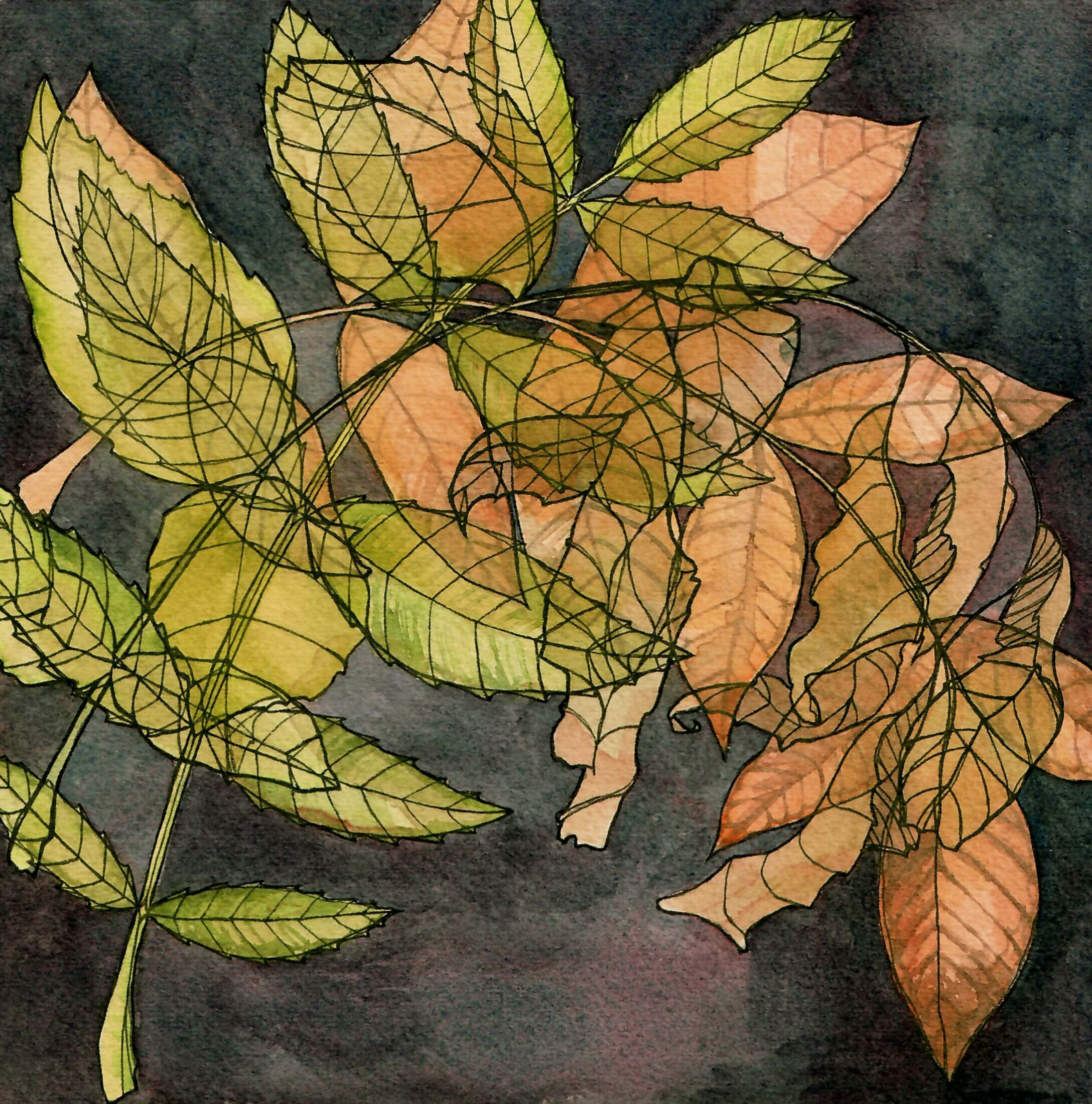
The ash tree was a living thing, but the more I looked at it, the more I saw it as a place, a habitat as well as an individual, bearing the traces of other lives, and tracing its own life through them.
Ash dieback is caused by a minute white fungus, which over a decade or more spread stealthily inside commercial shipments of ash trees until it became catastrophic for the tree across counties, landscapes, and continents. The late naturalist Roger Deakin, writing about ash trees, has said that an ash tree sometimes “will send out its branches in florid, Baroque spirals, for no apparent reason except exuberance.”
This is classic anthropomorphism. Nonetheless, I love how Deakin does not acknowledge that he does not know the why of what the tree is doing. His image of exuberance, each living individual as a host of other life forms, returned to me as I read the ecologist Oliver Rackham’s natural history, The Ash Tree. It was the sheer number of other life forms that had written their lifeways on, within, and through the ash, in life and in death. Many birds build their nests in ash trees; deer like to browse on the youngest shoots of ash trees in early spring; in winter, when food is scarce, rabbits and hares eat the bark; there are 111 types of insect or mite which depend on the ash tree, of which 29 are specific to ash; there are 26 mosses and 4 liverworts; there is a type of fungus known as King Alfred’s cake; the centre-barred sallow moth; the dusky thorn moth; earthworms have a taste for ash leaves, which they draw into the humus before fungi can compost it; as tree lichens decline in increasingly contaminated air, the ash is the last refuge for many species. When I went back to my ash tree in the park, I noticed the magpies fighting in its branches, the children arguing near the base, the long-gone hippies who had committed their artwork on its trunk, the half-built nest in the topmost twigs, the sock of mosses around the base, and the pale green, grey, and yellow tracings of lichen all across its surface. There was more going on, beyond what I could see.
If the yew tree and the cow, the cow and the human, showed me basic interactions between species, then the ash tree provided an exuberant flourishing without the human at the center. The ash tree was a living thing, but the more I looked at it, the more I saw it as a place, a habitat as well as an individual, bearing the traces of other lives, and tracing its own life through them. This is not to say that these are all the traces of collaboration: some of these species are mutually beneficial, but others harm or even kill ash trees, not least the new fungus. Ash dieback will expose and change the lives of these interdependent species as the ash is all but wiped out. Its spread has been enabled by the global circulation of wood and live trees.
In his conclusion to The Ash Tree, Rackham asks what can be done about this kind of catastrophe. Ash dieback, like those zoonotic diseases that threaten the human, was fueled by human capitalist and extractive processes. He is blunt on this: People need to “[g]et real. Stop letting the anthropology of commerce overrule the practical world.” A million exported container-grown trees carry with their roots a thousand tons of soil. “However thoroughly the Customs, or a responsible nurseryman [sic], inspect the consignment, they cannot detect a microscopic pathogen when they do not know in advance what to look for.”
I like the way Rackham inverts the habitual logic of economy and environment, wherein environmentalists are told that their hopes are not realistic. In his version, the mass extraction and circulation of living things comes to appear impractical. What is described, in arriving at this reversal, is a negative perception—a perception of what humans cannot perceive, the living world going beyond us—and Rackham suggests that it is practically possible to accept and allow for this excess. This would mean taking negative action; that is, not doing something, in this case, importing trees on a mass scale.
All the relationships I have described in this negative essay are unfair. It was difficult for Anne to persuade others to take her seriously, as a middle-aged, working-class woman. The young cow didn’t get a full postmortem, because it wasn’t considered valuable enough to us. (If it had been a racehorse, in contrast, its postmortem might have been more expensive than those received by many humans.) And trees and soil, like many other living things, are compelled to flow on a huge scale from poorer to wealthier countries. These inequalities range across scales and species; there are individual stories and there are global phenomena. They show how deaths are not, as convention would have it, the end of a story but are in fact moments in a larger network of stories; they’re moments of emergence-in-disappearance, or negative emergence.
For me, the stories are the thing—the stories concentrate much more than I can draw out of them as conclusion or thought, but I have been trying to draw attention to the ways in which the individual cow, human, or tree, in the process of becoming absent, exposes the imprints of its constitutive others in specific and different ways. That is, each death exposes other lifeways, because those lifeways will be changed by its absence. It exposes the relationships between the cow and the plant that grows near it, between the ash tree in a shipping container and the microbes that cling to its roots, between a woman who works in a supermarket and the cells inside her own body. Anne emphasized the importance of careful attention or listening. The heightened awareness of negative space that has come out of the COVID-19 crisis has drawn conscious attention to these connections and the fact that it is all but impossible for the human mind to take them all in. How many things have you been within a two-meter radius of today; how many times have you touched your face?
Of course, it’s easy to talk about listening, attunement, or love for the other. By looking at specific stories, I am trying to get at how these ideas bear out in active form. Spending time with the dying suggests to me that, when we are thinking about how or where to find ground in these weird and unstable times, it would be practically useful to have a stronger sense of a life’s negatives as the essential foothold for every existence. I was impressed by the way Anne had come to terms with her own nonexistence, and this, it seemed to me, enabled her to think clearly and generously about the terms on which she was alive. It is often imagined that ecological virtue will emerge naturally from a debt to future life. We’re told to recycle for the sake of our grandchildren, on the principle that they embody a version of ourselves that will be around for a long time. Perhaps it would be an interesting thought-experiment to refocus this to an attention to our own future nonexistence. Tell yourself to recycle because you are going to be not around for a long time.
It might be possible to discover in this, not nihilism (“what’s the point of doing anything if I am not there?”), but an increased belief in the value of the other beings whose conditions are entangled in our own lifeways. Any ecological morality must involve the kind of negative acts that COVID-19 has made familiar to many people in the world—not traveling, not extracting, not consuming. This negative action, which ecological activists have been calling for for years, has become a feature of daily life in the richest countries in the world with a speed that is shocking to anybody who has experienced the powerful resistance to these changes, most significantly in her government, but also in herself. There have been upheavals in the way people are living around the globe, involving massive renovations of life and society. All this exposes the reality that the richest countries are quite able to make these changes happen. They can see negative space. They know how to legislate for interconnection. They are more than able to compel those practical forms of care for one’s others that reveal themselves like negative love.
